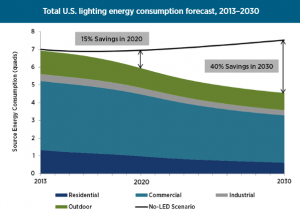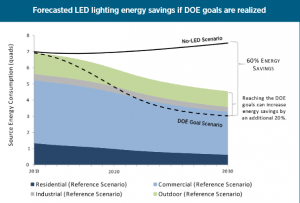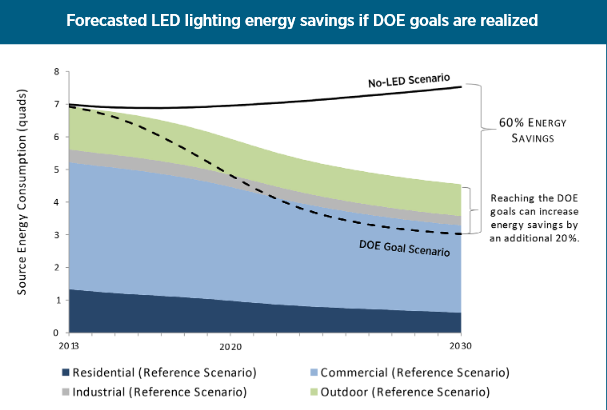Summary
The Department of Energy (DOE) has created a comprehensive analysis focused on the introduction and acceleration of LED lighting into the mainstream market. The DOE projects that by 2020, LEDs will have penetrated 48% of the market, and 84% by 2030. In addition, the DOE’s projects an ambitious $380 billion in electricity savings by 2030.
Study Findings
A new Department of Energy report titled Energy Savings Forecast of Solid-State Lighting in General Illumination Applications (a fancy way of saying modern LED lamps and bulbs) calculates energy savings of LEDs compared to non-LEDS (incandescents, fluorescents, halogens, and HID) from 2013 to 2030. In the report, the DOE creates two scenarios: a regular forecast and an ambitious forecast during this period. The regular forecast projects a conservative project of LED market penetration and energy savings. The ambitious forecast projects an optimistic projection of LED market penetration and energy savings. Both projections are calculated against a third scenario noted as the No-LED Scenario. In this scenario, it is assumed no more LEDs are introduced into the current and future markets.
Scenario 1
In Scenario 1, the DOE projects LEDs to gain a market penetration of 48% by 2020, and 84% by 2030. In addition, LEDs “. . . would reduce greenhouse gas emissions by approximately 180 million metric tons of carbon dioxide” (U.S. Department of Energy). Furthermore, LEDs would save 2,216 TWh of energy, equal to approximately $220 billion in savings.. To put these savings into perspective, 1 TWH is 1,000,000,000 kilowatt hours, so we’ll save 2,216,000,000,000 kWh of energy.

Source: U.S. Department of Energy
Scenario 2
In Scenario 2, LED lighting would achieve a market share of 68% in 2020 and over 90% in 2030” (U.S. Department of Energy). Compared to Scenario 1, the U.S. would see an additional 20% savings by 2030, leading to a 60% decrease (130 TWh) in total lighting energy consumption. That’s an additional 130,000,000,000 kWh saved. Overall, however, the U.S. would realize a total of 3,900 TWh in energy savings, which is equal to over $380 billion.

Source: U.S. Department of Energy
The National Lighting Bureau has helped summarize the DOE’s report. The following list the submarkets where LEDs are projected to dominate.
Indoor Lighting Submarkets
- Decorative-lamps
- Directional
- Linear fixtures
- Low-/high-bay
Outdoor Lighting Submarkets
- Streets/Roadways
- Parking
- Building exteriors
Among these, the DOE predicts the most rapid growth will be seen in the street/roadway and general service lighting submarkets.
Source: National Lighting Bureau
Bottom Line
LEDs save energy and money, and the more we introduce into the market, the more we’ll save. Based on supply and demand economics, LEDs will continue to become more affordable and available. Plus, we’ll start seeing them more on our streets, roadways, and general service areas, increasing safety. All that said, the U.S. is prime to become and stay a leader of energy efficiency for years to come.
Read the summary here: Energy Savings Forecast Summary
Read the full report here: Energy Savings Forecast




